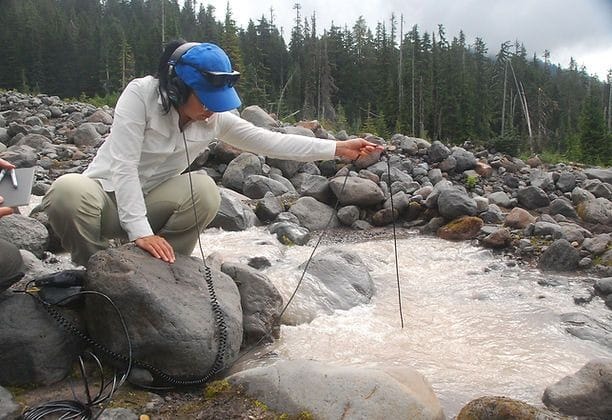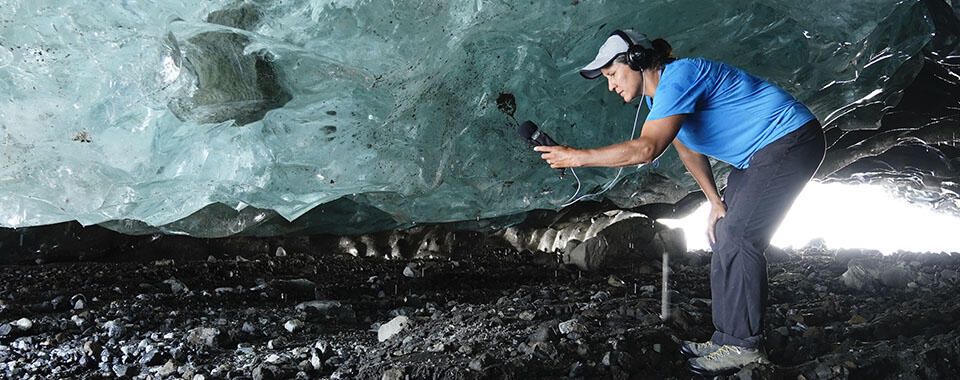I can listen to the sound of water contentedly for a very long time—rivers, waves, rainfall, dripping eaves—there is something both soothing and invigorating in the sounds of water. Many times, the mere sound of water falling, running, gushing, rolling has reassured me that there are things beyond my own worries—cycles and systems set in place by a God who continues to sustain them.
Susie Ibarra is a composer, percussionist, and sound artist who has long explored nature, community, and place through music, specifically through a wide range of traditional and unusual percussion instruments. She has listened to and created works based on the sounds of indigenous music, birds (who she has called the first percussionists), breath cycles and heartbeats, to name a few of her sources for albums, projects, and sound installations.
In an artist's statement, she says, “I spend most of my time listening. I listen to everything in my environment as much as I can—with my whole body and all of my senses. Sometimes, what I hear is as focused as a gong note; other times, the experience is as diffuse as a multitude of sounds rushing through me. Certain sounds ground me, and certain sounds allow me to float. I find myself drawn to these sounds, which so often come from the natural environment. Our systems and communities of sounds are built around nature... There are rhythms in the sounds of wind and travelers in a desert oasis. I hear a drumbeat in the noise and the movement of a child’s daily routine, the sound of an elder’s careful step as they descend the stairs. Rhythm is in cycles of life, both racing and whispering through sound.”
For the last few years, one of Ibarra's projects has been a work of collaboration with glaciologist, geographer, and climate scientist Michele Koppes. Ibarra and Koppes have been sonically mapping changes in glacier runoff "from the source to the sink." They have traveled to five of the world’s most important water towers including Easton Glacier in Washington State, the Blackcomb Glacier outside of Vancouver, the Greenland Ice Sheet, and the Indian Himalayas. They have placed hydrophones, spatial mics, and a field recorder near or in water and collected sound data, listening for changing patterns caused by a changing climate. (Mountains and highlands are often referred to as natural “water towers” because they provide lowlands with essential freshwater for irrigation, farming, industry, and homes). Ibarra explains the project with these words, “The cascading effects of climate change create their own sound; but no one has really bothered to listen.”
Ibarra and Koppes have created various installations and presentations using these recordings, including one called Himalayan Glacier Soundscapes, which begins at an elevation of 22,000 feet in the Himalayas at the source of Ganges River and follows the Ganges Delta over 1,200 miles, capturing sounds of life and nature along the way, immersing listeners in the sounds of the water and thus the realities of the two billion people who depend upon the water flowing down from the Himalayas to sustain their farms and communities.

Their collection contains a large variety of water-related sounds including the sounds created when water in its various forms encounters other objects and creatures, everything from underground rocks it shifts with its force—
to the sounds of creatures living on its edges, such as howling snow dogs.
The common thread is the water to which they are all connected and the sound recordings tie them together aurally in a way that helps the listener draw connections between what might seem like disparate entities. Water is the center of this storyline.

“When I transcribe the recordings of water, it’s pretty amazing,” Ibarra explains, “It’s beats and rhythms and tempos. It’s all very exact. It’s not ambient sound. It’s critical. It’s cultural. We follow the glacier melt ...We have recordings of ice caves in Greenland — they’re dripping and moving. It’s not at all static.” 1
When you listen to these recordings, is there anything that you find intriguing or surprising?
Below is a six-minute video created for the Water Rhythms Installation and Listening Room. Field recordings have been combined with images and words that describe the importance of ice and what it happening as the climate changes. What responses does this evoke in you?
Water Rhythms Video
As I experience Water Rhythms, it brings up mixed feeling for me because it suggests that the cycles and systems set in place are not, in actuality, the indestructible and undepletable forces that I envision and wish them to be. As I listen to the ice melting and see the graphics of receding glaciers, it brings home to me the responsibility we have as humans.
And yet, that responsibility also contains possibility. In the same way that humanity's actions can have a negative effect on climate, our actions can also have a positive effect. If actions and decisions can speed up climate change, that means that different decisions and actions can have the opposite effect. It may be that the water sounds I find so reassuring do not promise an unchanging reality. It may instead be that when we, as a species, are willing to grow up and accept responsibility, we can become the caretakers of this creation God intended us to be.
You can learn more about Susie Ibarra here and more from Michele Koppes about the Water Rhythms project here.
To leave a comment, click in the comment box below, or email me at info@circlewood.online.
Louise
